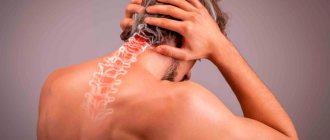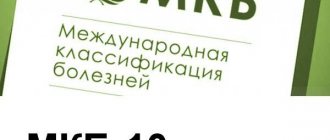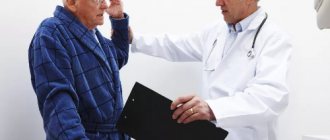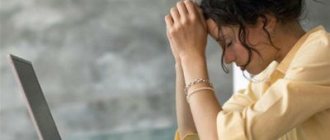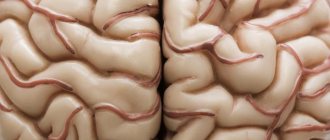Clinical picture of the condition
It is worth distinguishing a simple headache from sensations when pain occurs when pressure is applied. These symptoms signal different diseases; they are not equivalent to each other. If the cause of a migraine most often lies in impaired blood circulation in the brain and organic causes, then if the temple hurts when pressed, it is most likely due to problems with blood vessels, osteochondrosis, and heart pathologies.
Often pressure on the temple, accompanied by pain, is typical for older people and neurotic individuals. At the same time, symptoms such as increased anxiety, insomnia, sleep problems, irritability, unmotivated aggression, fixation on certain events, and difficulties in communication develop.
With such symptoms, it is highly recommended not to self-medicate. These may be manifestations of early dementia or neuropathy, encephalopathy. Drug treatment and competent selection of pharmacological agents will help stop the inevitable progression of the disease. And if the patient tries to self-medicate at home, the symptoms will increase, and after a few years the person may become incapacitated.
Treatment of left-sided headaches
Treatment is prescribed only based on the results of the examination. There are various techniques that can be used in the hospital and at home. So, in case of a sudden headache, doctors recommend ventilating the room, doing a neck and head massage, drinking water and taking a short rest. If the discomfort persists, you can take medicine. The most common recommendations from doctors against headaches include:
- painkillers that relieve acute pain - they can be taken at home, but should not be abused unnecessarily;
- antispasmodics - relieve vascular spasm and restore normal blood circulation;
- massage - it’s worth making an appointment with a specialist who will also show you how to reduce pain at home;
- physiotherapy is effective for osteochondrosis, neck diseases and during the rehabilitation period after injuries;
- specific treatment - you may need a course of drugs to strengthen intervertebral discs (chondrol protectors), drugs to normalize metabolism in atherosclerosis and other drugs to treat the underlying disease;
- surgical treatment is rarely used; it may be recommended in the presence of tumors, cysts and foci of sclerosis that interfere with the normal functioning of the brain and tend to increase in size.
The Clinical Brain Institute specializes in the treatment of diseases that manifest themselves as headaches. Qualified specialists of a wide and narrow profile work here, and there is also the opportunity to undergo a full examination, including specific techniques. There are different ways to get rid of a headache, but only a doctor can suggest the most effective and safe one.
Clinical Brain Institute Rating: 4/5 — 16 votes
Share article on social networks
Possible causes of this symptom
Why do my temples hurt when pressed? This is not a separate disease, but often signals serious health problems: cerebral vessels, blood pressure, vestibular system, cervical spine.
The most common diseases in which the temple hurts when pressed:
- cervical osteochondrosis;
- hypertension;
- vegetative-vascular dystonia;
- arrhythmia and cardiomyopathy;
- increased intracranial pressure;
- withdrawal syndrome;
- magnetic storms and increased atmospheric pressure;
- chronic stress and overwork;
- excessive physical activity (leads to overload of blood vessels and thinning of their walls).
Migraine, which every person has experienced at least once in their life, is also manifested by pain when pressing on the temple. Chronic migraine and vegetative-vascular dystonia have a lot in common, and only an experienced neurologist can distinguish one diagnosis from another based on the combination of a number of symptoms.
Headaches in the temple area
Headache in the temples is one of the types of cephalalgia, which occurs equally often in both men and women. It can be unilateral or bilateral, pulsating or pressing, last several minutes or drag on for several hours or even days. A headache that persists for a long time requires consultation with a neurologist, since there are many reasons for this condition.
In our Private Practice clinic, you can be examined by leading neurologist Larisa Aleksandrovna Baldorzhieva and receive an individual treatment plan at an affordable cost. You can make an appointment any day of the week using the phone numbers provided.
Causes and symptoms
Any pain requires careful differential diagnosis. Pain syndrome can be a consequence of neurosis or signal any somatic pathology. Below we will look at the most common causes of headaches in the temple area.
Change in blood pressure
Low blood pressure manifests itself in the form of a throbbing or pressing headache in the temples. In addition, weakness, nausea, flickering of spots before the eyes and coldness of the extremities are possible. With increased pressure, the pain is localized not only in the temples, but also in the back of the head. At the peak of high blood pressure, a person may experience nausea or even vomiting, the face begins to turn red, and photopsia (multiple flashes) appear before the eyes.
Stress
Against the background of chronic stress, all vital processes in the body are disrupted, including a deterioration in the tone of the vascular wall, an increase or decrease in blood pressure, causing prolonged pressing pain in the temples.
Migraine
Unilateral throbbing pain in the temple should alert the doctor to the possibility of migraine. Migraine is a hereditary disease that manifests itself in the form of instability of blood vessels in the brain. Such people often develop headaches due to climate change, severe stress and other external irritants. The disease itself does not cause serious harm to health, but it does cause a lot of inconvenience to a person. An attack can last from several seconds to several days, in some cases an “aura” occurs - a symptom complex that appears immediately before the onset of a migraine (spots before the eyes, nausea, photophobia, weakness, etc.).
Infection
If you have a headache in your temples, and the day before you sat for a long time in front of the air conditioner, it’s a cold. In addition to pain, other manifestations of infection may cause concern: runny nose, cough, hoarseness, weakness, fever.
Intoxication
Alcohol abuse and cigarette smoking have a negative effect on the walls of blood vessels, which leads to the development of pain.
Diseases of the musculoskeletal system
Osteochondrosis, neuralgia and other pathological conditions can cause shooting headaches affecting the back of the head, crown and/or temple.
Endocrine disorders
During puberty, pregnancy, lactation and menopause, hormonal imbalances may occur, leading to regularly occurring headaches. Also, due to diseases of hormone-producing organs (thyroid gland, pancreas), pain syndrome can begin spontaneously and go away with treatment of the underlying disease.
Dental pathology
This is one of the reasons that doctors often miss, attributing the occurrence of pain in the temples to nervous tension. If you haven’t been to the dentist for a long time, and you couldn’t determine the cause of your headache, contact your nearest dental clinic!
Diagnostics
Diagnostic measures at the Private Practice clinic include laboratory (blood and urine tests) and instrumental research methods (x-ray of the spine and skull, ultrasound of cerebral vessels, etc.). We have our own laboratory and modern diagnostic equipment.
Treatment
Headache is a symptom that has been successfully treated by a neurologist at our clinic for many years. The prescription of drugs depends on the cause of the pain syndrome. Dr. Baldorzhieva can prescribe nootropics, antidepressants, anticonvulsants, muscle relaxants, painkillers, depending on the situation. Osteopathic treatment of headaches provides excellent results, which is safe and effective. If necessary, the patient is referred for consultation with related specialists.
If you suffer from headaches in the temple area, do not self-medicate, contact the experienced doctors of our clinic and receive qualified medical care.
You can make an appointment with a doctor by calling
+7+7 (495) 980-13-16
Intracranial pressure
If intracranial pressure readings are significantly higher than normal, the patient feels a dull, prolonged pain in the back of the head and temples, which intensifies with strong pressure. People with increased intracranial pressure describe this condition as “as if water has accumulated in the skull and the head is about to burst.” This condition sometimes occurs immediately after waking up. In some patients, on the contrary, symptoms worsen in the late evening.
In some cases, changes in atmospheric pressure can provoke surges in intracranial pressure. This can cause the patient to wake up at night from a severe migraine, while pressure on the temples and back of the head will cause acute pain. Chronic stress and overwork can also cause increased intracranial pressure.
In the absence of drug treatment and lifestyle changes, intracranial pressure can lead to organic changes that cause permanent chronic ailments. In the future, this may threaten the patient with the possible development of encephalopathy, various neuropathies, and a decrease in cognitive functions.
Diseases of the cardiovascular system
Unstable functioning of the heart and blood vessels is a common cause of headache when pressed. These are serious conditions in which self-medication is unacceptable and consultation with a cardiologist is necessary. Does your temple on the right side hurt when pressed and do you feel pulsation of the veins? Most likely the cause is arrhythmia. This condition also often causes dizziness, darkening of the eyes, and short-term fainting. The patient feels weak and nauseated. Does your temple on the left side hurt when you press? Perhaps the reason is surges in blood pressure. It must be measured regularly to rule out hypertension.
With the combination of all these symptoms, we can talk not only about arrhythmia, but also about angina pectoris and cardiomyopathy. When blood pressure rises, the nature of the pain in the temples is stabbing or throbbing. If the indicators are lowered, then nagging discomfort, dizziness appears, and a short-term loss of consciousness may occur.
In some cases, problems with the functioning of the cardiovascular system are caused by changes in atmospheric pressure, weather changes, and chronic stress. This condition cannot be left to chance. It can lead to chronic diseases of the heart and blood vessels.
Prevention
To prevent discomfort in the temple area, it is recommended:
- change your diet;
- stop drinking alcoholic beverages and smoking;
- do exercises in the morning;
- spend more time in the fresh air;
- avoid injury;
- reduce exposure to heat in summer;
- observe drinking regime;
- reduce coffee consumption;
- maintain a sleep and rest schedule;
- avoid stressful situations;
- undergo regular medical examinations;
- if necessary, monitor blood pressure;
- take vitamin and mineral complexes.
A good way to prevent pain in the temples is to use some folk remedies. For example, if you have a tendency to arterial hypertension or neuroses, it is recommended to add dry herb of valerian officinalis to tea. Honey will help prevent the development of pain in the temple area: regular use of 1-2 teaspoons of this remedy at night will help normalize sleep and get rid of mental or physical stress.
Hormonal disorders
If a woman has pain near her temple when pressed, then perhaps it is due to diseases of the hormonal system. With thyrotoxicosis, the symptoms are varied - migraines and pain in the back of the head and temples when pressed can occur. If there is a deviation in TSH levels, hair loss (alopecia), asthenia, dysphoria, irritability, and anxiety are also possible.
Another reason why temples hurt when pressed is premenstrual syndrome. This condition is not a disease and occurs in approximately 30% of women aged 16 to 43 years. To avoid it, before the onset of menstruation, you should rest more, avoid physical activity, hypothermia, and stress. In some cases, a course of vasodilator drugs will help. A prescription for such medications can be obtained from a neurologist.
Local diseases
If it hurts just below the temple when pressed (the sensation is not located in the temple itself, but next to it), then most likely the cause is local diseases. These are meningitis, sinusitis, inflammation of the nasopharynx and sinuses, ARVI, and other infectious diseases. This is due to an increase in temperature and the accumulation of mucus in certain parts, which with its volume puts pressure on the tissues of the skull.
To treat such conditions, antiviral and immunomodulatory drugs should be used. These are “Kagocel”, “Sinupret”, “Arbidol” and others. An immunologist can prescribe a medicine that would be ideal for a particular patient and does not cause side effects.
If the temple on the right side hurts when pressed (at the same time there is nasal congestion, sore throat, swollen lymph nodes and other symptoms of ARVI and influenza), then the inflammatory process occurs on the right side of the nasopharynx, tonsils and sinuses. It is necessary to more actively use medicinal aerosols and sprays specifically for the treatment of the right nostril and the side of the throat. Does your temple on the left side hurt when you press? Accordingly, the inflammatory process is more active on the left.
Vegetovascular dystonia
This disease is a complex of functional disorders, which is based on dysregulation of vascular tone of the autonomic nervous system. This is a common reason why the right temple hurts when pressed. Vegetative-vascular dystonia is characterized by pain in the temples and without pressure. In the early stages, it is simply an unpleasant squeezing sensation, as if the head is in a vice. In parallel with this, the patient often experiences anxiety, unmotivated fear, phobias, and depressive disorders appear.
There is an opinion among patients that a neurologist makes a diagnosis of “vegetative-vascular dystonia” if he cannot correctly diagnose it. Allegedly, the symptoms of VSD are so extensive that they can be attributed to every second resident of our country. A competent neurologist will only laugh at such a statement: the diagnosis of “vegetative-vascular dystonia” has clear symptoms and really exists, although it is difficult to treat with medication. The patient's condition with this disease can be significantly alleviated not by pills and injections, but by changing lifestyle and giving up bad habits (in particular, smoking cigarettes).
Causes
The main cause of pain in the temples is a violation of the tone of the wall of cerebral vessels. In people under the age of 35, pain occurs with vegetative diseases, migraines or increased intracranial pressure. In elderly patients with such complaints, it is necessary to exclude arterial hypertension and serious pathological changes in the brain of the atherosclerotic type. If, with pain in the temple, the patient feels heaviness in the occipital region, this may indicate intoxication of the body.
So, the main causes of discomfort are considered to be:
- atherosclerosis;
- flu;
- alcoholic delirium;
- infectious sore throat;
- stroke;
- cerebral angiodystonia;
- arterial hypertension;
- temporal arteritis;
- migraine;
- cluster pain;
- neuralgia;
- inflammation of the trigeminal nerve;
- osteochondrosis of the cervical spine;
- osteoarthritis;
- hormonal disorders during menopause or pregnancy;
- increased intracranial pressure;
- vegetative-vascular dystonia.
In some cases, the cause of a headache localized in the temple may be mental or emotional stress, as well as stress, regular lack of sleep, or taking certain medications. In addition, eating certain foods can provoke discomfort in the temple: spicy Asian dishes, excessively salty foods (especially with a large amount of glutamate), fast food, smoked meats.
When pressed from the left side
Severe pain in the left temple is usually caused by various reasons: inflammatory diseases of a bacterial or viral nature, allergic reactions. They contribute to the development of pressing, dull and constant pain. Discomfort appears not only in the left temporal region, but also in the forehead, cheeks, and sometimes the auricle. If the pathological condition is accompanied by an increase in body temperature, the patient notes congestion or noise in the ears.
If there is pressure on the left temple not constantly, but periodically, mainly in the late afternoon, after a school or work day, then you should think about the psychogenic nature of the disease. In this case, it is necessary to increase the duration of sleep, the duration of walks in the fresh air, and eliminate the consumption of strong coffee and alcohol. Often, if the left temple hurts when pressed, inflammatory diseases of the middle ear or nasopharynx are detected. Sometimes this condition is accompanied by unpleasant sensations in the eyes.
On the right side
Pain in the right temple appears when the tone of the vascular wall of the arteries is disturbed. In addition, sometimes they indicate the presence of autonomic dysfunction, high blood pressure, and atherosclerotic lesions. Additional symptoms include heaviness in the head, clouding of consciousness, loss of concentration and attention. If the right temple hurts severely, then this indicates intoxication of the body due to infectious diseases, influenza, pneumonia.
Pain syndrome localized to the right indicates migraine and is accompanied by photophobia, nausea, loss of performance, sleep disturbances and weakness. Often excruciating pulsating painful sensations occur with hormonal disorders, inflammation of the walls of the temporal vessels, traumatic brain injuries and pathologies of the cranial nerves.
- Mildronate - instructions for use. Indications for taking the drug Mildronate in capsules, tablets and injections
- How to cook mushrooms correctly. How long to cook frozen, dried or fresh mushrooms
- How to get rid of acne on the butt at home. Quick relief from acne on the butt
Osteochondrosis of the cervical spine
Has several stages. At the initial stage of development, this disease makes itself felt only by mild dizziness. In some cases, vision decreases (because the optic nerve is pinched). At the second stage, the patient begins to experience headaches, and short-term loss of consciousness is possible. The main difference between osteochondrosis and increased intracranial pressure is that the neck and shoulders hurt, and the cartilage crunches when you rotate your head.
If, in parallel with these symptoms, the patient’s temple hurts when pressed, then we can confidently say that the problem is precisely osteochondrosis of the cervical spine. The treatment of this pathology is carried out by an orthopedist and a neurologist. The following medications are prescribed:
- Intramuscular injections of drugs that include cyanocobalamin, pyridoxine, thiamine, riboflavin, nicotinic acid.
- Over-the-counter mild nootropics.
- Vasodilators.
- Medicines designed to compensate for the deficiency of collagen and elastin in the body.
Why do TMJ dysfunctions occur?
The causes of development are divided into two types: general and local.
- General ones are various kinds of infectious diseases, metabolic disorders, diseases of the endocrine system, which lead to inflammation of ligaments, muscles and cartilage tissue.
- Local injuries and excessive load on the articular surface of the head of the mandible. It can be “overloaded,” for example, due to the absence of lateral teeth, malocclusion and bruxism: strong clenching of teeth that occurs due to stress and psycho-emotional disorders. In addition, the condition of the TMJ is affected by our posture, problems with the cervical spine, and so on.
The TMJ is a paired joint and works synchronously. This is an incredibly harmonious and “delicate” system that fails relatively easily: it is enough to lose a couple of teeth, and the load on the joint will change, which will lead to the restructuring of connective and bone tissues. As a result, congruence of the articular surfaces occurs - a violation of articulation.
Arteritis of the temporal region
Arteritis is an inflammatory disease of the arteries.
A rather rare disease in which a small lump forms on the temple, hurts when pressed and pulsates. It occurs most often in people over fifty years of age. The appearance of arteritis in young people is possible in isolated cases only in the presence of a genetic predisposition.
Arteritis is treated by a neurologist, surgeon, and therapist. At the same time, the patient may suffer from migraines, a feeling of fluid accumulation in the brain, and surges in blood pressure.
Hangover and withdrawal symptoms
The morning after a stormy party brings not only headaches and nausea, but also serious stress on the arteries and blood vessels. The body struggles with the consequences of severe ethanol intoxication. Due to the suppression of the tone of the vascular walls, people often complain that it hurts near the temple when pressed. Depending on the individual characteristics of the sick person, the pain may be located in the back of the head or forehead. In some cases, the left temple hurts when pressed, but the right one does not.
In this case, there is only one treatment - try to remove toxic products from the body as quickly as possible. To do this, you can use Enterosgel, preparations with activated carbon in the composition. After severe intoxication, it is necessary to take a course of vitamins with magnesium, selenium, and iodine.
Often such patients complain: “I press on my temple and it hurts.” They often exaggerate the scale of the problem. If pain in the back of the head and temple occurs after alcohol abuse, you should not run to the doctor and look for serious pathologies. It’s enough to simply eliminate ethanol-containing drinks from your diet once and for all.
What to do if you have problems with TMJ?
Joint problems are diagnosed using MRI, radiography, and computed tomography. Treatment is carried out depending on the causes of dysfunction: if the cause is an infection, then the infection is treated and the inflammation is relieved. If the bite is incorrect, you need to contact an orthodontist. Painkillers help temporarily relieve pain.
Osteopathy is very helpful in eliminating the problem. Osteopathic manipulations are aimed at correcting the position of the lower jaw; they act directly on the muscles and ligaments, helping the bones and tissues “fall” into place. This is especially effective when working together with dentists, orthodontists, rheumatologists, and other doctors. In addition, the treatment of TMJ often requires correction of intraosseous tensions in the bones of the facial skull, hyoid bone, dysfunction of the cervical and thoracic spine, problems with internal organs, etc. Few people know, but in 2-3 cases out of 10 our posture depends on the position of the lower jaw and the TMJ.
Just one session with an osteopath in many cases helps reduce the intensity of pain by 80%.
Which doctor should I consult if my temple hurts when pressed?
First you need to get a voucher to see a therapist. He will prescribe the standard necessary tests - a biochemical blood test, a general urine test. After receiving the results, the overall clinical picture will become clearer. If leukocytes are elevated, then the cause of pain in the temple is most likely caused by inflammatory processes in the sinuses, lymph nodes, and nasopharynx. This condition is easily treatable.
If the tests are normal, the therapist will give you a coupon for a consultation with an endocrinologist and a neurologist. For patients who find it unpleasant to be in a public clinic and do not have time to wait their turn, there are paid diagnostic centers. There you can make an appointment directly with an endocrinologist, surgeon and neurologist. In this case, tests and procedures will also be paid.
What are the symptoms of TMJ dysfunction?
Dystrophic changes rarely develop in one day. This is a gradual process. Usually the initial stages are characterized by painful sensations: the masticatory muscles ache, the pain radiates to the temples and head, to the ears. Patients may confuse problems with TMJ with otitis media or toothache and often seek help from a dentist, who does not find any problems with the teeth, but detects incipient pathology of the joint.
Another characteristic sign is crunching and clicking sounds when yawning, chewing food, or talking. Then chewing and speaking becomes uncomfortable, and the patient begins to “protect” the jaw, reducing the amplitude of mouth opening. This leads to other problems: with the articulation of sounds, with chewing food. Due to the constant tension of the neck muscles, the head hurts more and more often, and the skin of the face may become numb.
Often the problem occurs after dental prosthetics. There is nothing surprising in this: the installation or removal of teeth leads to a redistribution of the load in the mouth, which can cause pain in the joint.
And all this can ultimately lead to tissue degeneration (erasure of cartilage) and stiffness of the TMJ - arthrosis.
How is diagnosis carried out and possible treatment options?
To find out the exact reason why it hurts above the temple when pressed, you will have to undergo a series of studies. If a patient goes to a clinic at his place of residence, he is required to provide all procedures free of charge (everything will be paid for by the insurance company with which the sick person is registered under the medical policy). As mentioned above, if the patient does not have time to wait for an appointment with a coupon in public medical institutions, he can go to private diagnostic centers and undergo diagnostics for a fee.
To diagnose the severity of osteochondrosis of the cervical spine, MRI and CT are prescribed. After determining the stage, the neurologist prescribes treatment. These can be either ordinary vitamin-mineral complexes, physiotherapy and exercise therapy, or serious prescription anesthetic drugs. It all depends on how far the pathological condition has gone.
To diagnose vegetative-vascular dystonia, it is enough for a neurologist to compare a number of symptoms. There is no research that could help accurately identify this disease. In some cases, it makes sense to undergo an MRI of the brain vessels. The cost of such a study is about seven thousand rubles in paid diagnostic centers. MRI of cerebral vessels is informative and will help establish an accurate diagnosis not only for VSD, but also for organic brain disorders, intracranial pressure, and encephalopathy.
